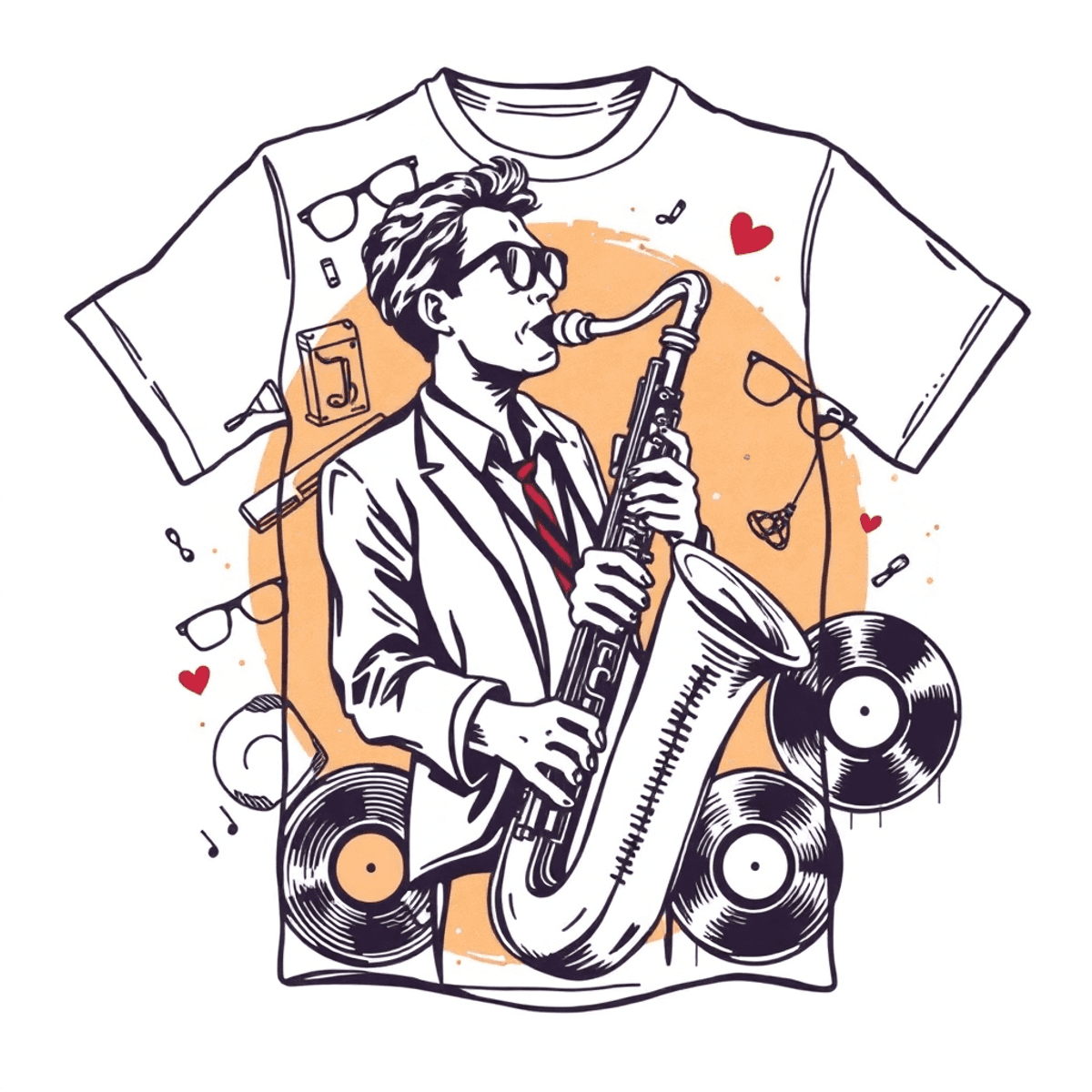From Subculture to Mainstream: The Evolution of Hipster T-Shirt Design

Introduction
The hipster movement has transformed from a small, underground subculture into a global fashion phenomenon that’s reshaped the landscape of contemporary style. At the heart of this evolution lies the humble T-shirt – a canvas for self-expression that captures the essence of hipster culture’s creative spirit.
Hipster T-shirt design emerged as a rebellious response to mass-produced fashion, characterized by:
- Vintage-inspired graphics that blend nostalgia with irony
- Hand-drawn illustrations celebrating artisanal craftsmanship
- Clever wordplay and cultural references that signal insider knowledge
- Upcycled materials reflecting environmental consciousness
The impact of hipster fashion extends far beyond clothing racks. These distinctive designs have sparked conversations about authenticity, consumerism, and personal identity in the digital age. What started as a niche market for independent designers has now influenced major fashion retailers, creating a fascinating paradox where counter-culture meets commercial success.
As hipster T-shirt designs migrate from thrift store finds to mainstream retail spaces, they tell a compelling story about cultural transformation. This shift reflects broader changes in how we express individuality, consume fashion, and navigate the complex relationship between alternative and mainstream culture in today’s society.
The Early Days: Jazz, Beatniks, and the Birth of Hipster Fashion
The term “hipster” emerged from the vibrant jazz clubs of 1940s Harlem, where musicians and their devoted followers crafted a distinctive cultural identity. These original hipsters distinguished themselves through their appreciation of bebop jazz and a unique fashion sense that rejected mainstream conventions.
The Influence of Jazz Musicians on Hipster Style
The early hipster aesthetic drew inspiration from the sharp, sophisticated styles of jazz musicians:
- High-waisted trousers paired with loose-fitting shirts
- Berets and flat caps as signature accessories
- Zoot suits with exaggerated shoulders and tapered legs
- Simple white t-shirts – a rebellious statement in formal society
The Beat Generation’s Impact on Hipster Fashion
The 1950s saw the rise of the Beat Generation, with influential figures like Allen Ginsberg and Jack Kerouac reshaping hipster fashion through their rejection of post-war conformity. Their style choices reflected a deliberate break from conventional dress codes:
“The only people for me are the mad ones, the ones who are mad to live, mad to talk, mad to be saved” – Jack Kerouac
The Beats introduced several elements that would become foundational to hipster fashion:
- Black turtlenecks and basic t-shirts
- Worn denim and workwear
- Military surplus items
- Thrifted clothing
The Cultural Shift: From Undergarment to Self-Expression
This fusion of jazz culture and Beat sensibilities created a distinct visual language that emphasized individuality and authenticity. The simple t-shirt emerged as a powerful symbol of this cultural shift, transforming from an undergarment to a canvas for self-expression.
Core Values of Hipster Culture: Artistic Authenticity and Materialism Rejection
The Beat poets’ influence extended beyond clothing – their emphasis on artistic authenticity and rejection of materialism became core values of hipster culture. These early adopters established a pattern of using fashion as a form of cultural resistance, setting the stage for future generations of hipsters to follow.
This historical context is crucial in understanding the evolution of hipster culture, which has transcended its initial confines to become a global phenomenon characterized by its unique blend of art, music, fashion, and lifestyle choices.
Characteristics of Hipster Fashion: Vintage Vibes and Eclectic Styles
Hipster fashion thrives on a distinct blend of vintage elements and unconventional style choices. The core aesthetic revolves around three fundamental principles:
- Thrifted Treasures: Second-hand clothing forms the backbone of hipster style, with vintage pieces from the 1960s through 1990s taking center stage
- Pattern Play: Bold mixing of prints, textures, and unexpected color combinations
- DIY Philosophy: Handcrafted modifications and personalized touches that transform ordinary pieces into unique statements
The hipster wardrobe draws inspiration from multiple subcultures, creating a rich tapestry of influences. Grunge’s laid-back attitude manifests in oversized flannel shirts and distressed denim, while punk’s rebellious spirit appears through DIY customizations and statement accessories.
Key elements of hipster style include:
- Vintage-Inspired Pieces
- High-waisted pants
- Classic band t-shirts
- Retro athletic wear
- Heritage workwear
- Pattern Combinations
- Plaid-on-plaid layering
- Floral prints with geometric designs
- Mixed textile patterns
- DIY Modifications
- Hand-painted designs
- Patch additions
- Strategic distressing
- Custom embroidery
The hipster aesthetic embraces imperfection and authenticity. Clothing often shows signs of wear, celebrating the history and character of each piece. This approach stands in direct opposition to fast fashion’s mass-produced uniformity.
The influence of various decades blends seamlessly in hipster fashion. A typical outfit might pair 1970s high-waisted jeans with a 1990s crop top and 1980s accessories. This time-traveling approach to style creates unique combinations that define the eclectic hipster look.
The DIY ethos extends beyond clothing modifications. Hipsters often create their own accessories, from hand-knitted scarves to screen-printed tote bags. This maker mentality reinforces the movement’s emphasis on individuality and artistic expression.
The Power of Graphics: Ironic Designs and Retro Nostalgia in Hipster T-Shirts
Hipster t-shirt designs thrive on a delicate balance of irony and nostalgia, creating visual statements that both celebrate and satirize popular culture. These designs often feature deliberately obscure references, ranging from vintage corporate logos to forgotten TV shows of the 1980s.
The art of hipster graphic design revolves around several key elements:
- Intentionally Dated Typography: Comic Sans, chunky serif fonts, and retro-inspired letterforms
- Faded Color Palettes: Muted tones that mimic well-worn vintage shirts
- Pop Culture Mashups: Combining unexpected elements (like Mozart wearing headphones)
- Hand-Drawn Elements: Imperfect illustrations that emphasize authenticity
Popular design motifs include:
- Reimagined Brand Logos: Taking familiar corporate symbols and subverting their meaning
- Nostalgic Technology: Cassette tapes, old gaming consoles, vintage cameras
- Ironic Phrases: Self-aware statements that mock conventional wisdom
- Local Pride: References to obscure neighborhood landmarks or events
The humor in hipster t-shirt designs often stems from their ability to create inside jokes among wearers. A shirt featuring a defunct local video rental store speaks to shared experiences and cultural memory. These designs serve as conversation starters, allowing wearers to demonstrate their cultural knowledge and authenticity.
Tongue-in-cheek slogans play a crucial role in hipster t-shirt appeal. Phrases like “I liked this shirt before it was cool” or “Professional Amateur” exemplify the self-aware nature of hipster humor. These designs often incorporate visual elements that deliberately clash with their messages, creating layers of irony that reward close inspection.
The rise of digital design tools has enabled creators to perfect the “imperfect” look characteristic of hipster graphics. Designers carefully craft distressed effects and misaligned prints to achieve an authentic vintage appearance. This attention to detail transforms mass-produced items into pieces that feel unique and personally discovered.
From Niche Market to Global Phenomenon: The Mainstreaming of Hipster T-Shirts
The transformation of hipster t-shirts from exclusive boutique items to mainstream fashion staples marks a significant shift in retail dynamics. Major chains like Urban Outfitters, H&M, and Zara recognized the commercial potential of hipster aesthetics in the mid-2000s, leading to mass-produced versions of designs previously found only in independent stores.
This mainstreaming process created two distinct market segments:
- Mass-Market Interpretations: Large retailers offering affordable hipster-inspired designs
- Premium Authentic Pieces: Independent boutiques maintaining exclusivity through limited editions
The Impact of Global Supply Chain on Hipster T-Shirt Production
The global supply chain revolutionized hipster t-shirt production. What started as small-batch screen printing in local workshops evolved into large-scale manufacturing operations across Asia. This shift dramatically reduced production costs, making hipster-style t-shirts accessible to broader audiences.
Key Factors Driving Mainstream Adoption of Hipster Fashion
Several key factors contributed to the widespread acceptance of hipster fashion:
- Price Point Evolution: Independent boutiques typically priced their items between $50 and $200, while mass-market versions were available at $15 to $40.
- Distribution Channels: Hipster fashion gained visibility through department store presence, shopping mall availability, and online retail integration.
Changing Consumer Behavior: Mixing High-End and Mass-Market Pieces
The democratization of hipster fashion sparked changes in consumer behavior. Young shoppers now mix high-end boutique pieces with mass-market interpretations, creating personalized styles that blend authenticity with accessibility.
Major Retailers’ Response: Adapting Strategies to Capitalize on Trends
To capitalize on this trend, major retailers adapted their business strategies:
- Collaborations with independent designers
- Limited-edition releases
- “Capsule collections” featuring artistic designs
The Dual Nature of Commercialization: Benefits and Challenges
This commercialization brought both benefits and challenges. While increased accessibility allowed more people to participate in hipster fashion, it also diluted the subculture’s original emphasis on uniqueness and authenticity. Fast-fashion retailers now produce hundreds of thousands of units featuring designs that once existed in quantities of dozens.
The Role of Digital Age in Accelerating Mainstreaming Process
The digital age accelerated this mainstreaming process. Social media platforms spread hipster aesthetics globally, creating demand in markets far beyond traditional urban centers. International shipping options enabled retailers to serve customers worldwide, transforming local trends into global fashion statements.
Critiques from Within: Authenticity Issues and Consumerism in Hipster Culture
The hipster movement faces a significant paradox: its core values of authenticity clash with its commercial success. This tension creates a complex dialogue within the community about the true meaning of hipster identity.
The Authenticity Dilemma
- Original hipster T-shirts emerged as statements against mass production
- Hand-printed designs represented personal artistic expression
- Limited runs created unique pieces that told individual stories
Yet the mass production of “authentic” hipster designs raises questions about cultural appropriation and commodification. Major retailers now produce pre-distressed shirts with “vintage” designs at scale, mimicking the aesthetic of genuine thrift store finds.
The Co-opting Controversy
- Independent artists watch their designs become mass-produced
- Thrift store aesthetics transform into premium-priced “vintage-inspired” pieces
- DIY culture becomes a marketable commodity
The debate intensifies as hipster culture grapples with its own success. Many early adopters argue that true hipster fashion died when mainstream retailers began selling mass-produced versions of their carefully curated looks.
The Price of Popularity
- $5 thrift store finds reimagined as $50 “authentic reproductions”
- Small-batch production methods replaced by factory assembly lines
- Local artist collaborations overshadowed by corporate design teams
This commercialization creates an identity crisis within hipster communities. Some embrace the wider accessibility, while others seek new ways to maintain authenticity through micro-brands and truly limited editions.
A growing number of hipsters now reject branded “hipster” clothing entirely, viewing it as a contradiction to the movement’s anti-consumerist roots. They’re returning to genuine vintage pieces and supporting local artists who maintain small-scale production methods.
The authenticity debate reflects deeper questions about subcultural identity in a capitalist society. Can a movement maintain its core values while existing within the very system it originally sought to critique?
Modern-Day Hipsters: Social Awareness Meets Artisanal Craftsmanship in T-Shirt Design
Contemporary hipster T-shirt design has evolved into a powerful medium for social commentary and artistic expression. The intersection of activism and fashion has given birth to designs that speak volumes about current social issues:
- Climate Change Awareness – Hand-drawn illustrations of endangered species paired with thought-provoking statistics
- Social Justice Messages – Bold typography featuring calls for equality and human rights
- Mental Health Advocacy – Abstract designs incorporating positive affirmations and mental health resources
- Local Community Support – Graphics celebrating neighborhood landmarks and small businesses
Independent designers have revolutionized the production process through artisanal techniques:
- Screen printing by hand
- Natural dye processes
- Upcycled fabric usage
- Small-batch production methods
These craftsmanship-focused approaches create unique variations in each piece, making every T-shirt a one-of-a-kind artwork. The attention to detail extends beyond the graphics – you’ll find hand-stitched labels, custom hang tags, and even personalized notes from the creators.
Local artists have established micro-brands that challenge mass production norms:
“Each shirt tells a story – from the sourcing of materials to the final stitch. We’re not just selling clothes; we’re creating wearable art that sparks conversations.” – Sarah Chen, Independent Designer
The rise of social media has amplified these independent voices, creating tight-knit communities around specific design aesthetics and causes. Designers now collaborate directly with activists and non-profit organizations, creating limited edition pieces that raise awareness and funds for various social causes.
Popular design elements include:
- Minimalist line drawings
- Vintage-inspired typography
- Hand-lettered manifestos
- Abstract watercolor effects
- Geometric patterns with hidden meanings
These artistic choices reflect a deeper commitment to authenticity and social responsibility, pushing the boundaries of what T-shirt design can accomplish in the modern age.
Etsy Revolution: How Online Platforms Empower Independent Designers in the Hipster Market Segment
Digital marketplaces have changed the game for independent designers, allowing them to connect with their audience like never before. At the forefront of this movement is Etsy, a platform that has created a direct link between creators and consumers who are on the lookout for one-of-a-kind, handmade t-shirt designs.
The Success Behind Etsy
Etsy’s success can be attributed to several key factors:
- Breaking Down Barriers: Independent designers no longer need to rely on traditional methods or invest large sums of money to start their brands. With Etsy, they can launch their businesses with minimal upfront costs.
- Reaching a Global Audience: Small-scale creators now have the opportunity to sell their products to customers all over the world. This global reach expands their market potential and opens up new avenues for growth.
- Telling Authentic Stories: One of the unique aspects of Etsy is its emphasis on storytelling. Designers have the ability to share their creative process, inspirations, and brand values directly with buyers, creating a deeper connection between artist and customer.
- Building Communities: The platform fosters direct communication between artists and customers, allowing for meaningful interactions and relationship-building. This sense of community can lead to repeat purchases and word-of-mouth referrals.
The Rise of Customization
The popularity of personalized t-shirt designs through online platforms has ushered in a new era of customization. Today, buyers have higher expectations when it comes to their apparel:
- Made-to-order sizing options
- Custom color variations
- Personal message incorporation
- Limited edition releases
Independent designers on Etsy have been quick to adapt to these demands, coming up with innovative business models that cater to the needs of their customers.
Innovative Business Models
Here are some examples of how independent designers on Etsy are finding success:
- Drop Shipping Partnerships: Many creators are partnering with specialized printers who handle production and fulfillment. This allows designers to focus on what they do best – creating unique designs – while leaving the logistics to experts.
- Pre-Order Campaigns: To mitigate inventory risks and ensure sustainable production practices, some designers are implementing pre-order campaigns. By gauging demand before committing to large production runs, they can minimize waste and create products that align with customer preferences.
- Collaborative Collections: Multiple artists joining forces to create limited-edition design series is another trend gaining traction on Etsy. These collaborations not only bring fresh perspectives but also attract fans from each participating artist’s following.
- Seasonal Capsules: Limited-time releases tied to specific seasons or events create a sense of urgency among buyers. By offering exclusive designs that are only available for a short period, designers can drive sales and generate buzz around their brand.
Targeted Approaches
Etsy’s search algorithms and tagging systems play a crucial role in helping niche designers find their target audience segments. By optimizing their product listings with relevant keywords and tags, creators can increase visibility and attract potential customers who are specifically interested in their style or theme.
This targeted approach enables independent designers to:
- Build dedicated followings
- Develop signature styles
- Test new design concepts
- Adapt quickly based on market feedback
A Shift in T-Shirt Design
Thanks to digital marketplaces like Etsy, t-shirt design has evolved from being solely mass-produced into an art form that celebrates individuality. The growing demand for unique, independently created designs reflects society’s desire for self-expression through fashion.
As more people seek out clothing items that resonate with their personal style preferences and values, platforms like Etsy will continue playing an instrumental role in empowering independent designers within this hipster market segment.
Conclusion: The Lasting Impact of Hipster T-Shirt Design on Fashion and Identity Politics
Hipster T-shirt design has come a long way, evolving from an underground movement to a global phenomenon. This transformation has redefined the relationship between fashion and personal identity. What initially started as a rejection of mainstream culture has now become a powerful force in shaping it, creating an intriguing paradox where counterculture meets commercial success.
This evolution has sparked three significant shifts in fashion culture:
- Democratization of Design: Anyone with creativity can now become a T-shirt designer, breaking down traditional barriers between consumers and creators
- Authenticity in Mass Production: The demand for unique, meaningful designs has pushed major retailers to embrace artisanal aesthetics
- Social Commentary Through Fashion: T-shirts have evolved into powerful vehicles for expressing political views and social values
Looking ahead, hipster T-shirt design shows signs of evolving into new forms of expression:
- Increased focus on sustainable production methods
- Integration of technology with traditional design elements
- Growing emphasis on local cultural elements in global markets
The legacy of hipster T-shirt culture lives on in the way we approach fashion today – as a blend of personal expression, social consciousness, and artistic innovation. This intersection of style and substance continues to shape how future generations will use clothing to tell their stories and challenge societal norms.
FAQs (Frequently Asked Questions)
What is the significance of hipster T-shirt design in contemporary fashion?
The journey of hipster T-shirt design from niche to mainstream has significantly influenced the fashion industry, shaping how we perceive identity and consumerism in contemporary society.
How did the hipster subculture originate?
The term ‘hipster’ emerged in the 1940s jazz scene, influenced by early fashion styles and figures from beatnik culture, such as Allen Ginsberg and Jack Kerouac.
What are the defining characteristics of hipster fashion?
Hipster fashion is characterized by vintage elements, eclectic styles, thrifted clothing, pattern mixing, and a DIY ethos. It draws inspiration from various subcultures like grunge and punk.
What role do graphics play in hipster T-shirt design?
Graphics in hipster T-shirts often feature ironic designs and retro nostalgia. Popular motifs include vintage logos and tongue-in-cheek slogans that resonate with humor and cultural references.
How have hipster T-shirts transitioned into mainstream retail?
Hipster T-shirt designs have moved from exclusive independent boutiques to dominating major retail chains due to their commercial viability and the impact of globalization, which has made these designs more accessible and affordable.
What challenges does hipster culture face regarding authenticity?
There is ongoing debate about whether true authenticity can exist within a commercially-driven subculture like hipsterdom, raising questions about co-opting culture and maintaining genuine self-expression amidst mass production.










